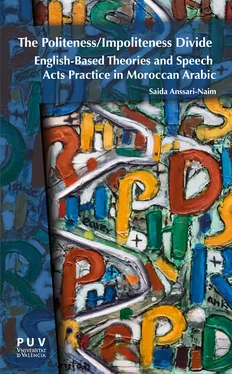Bald on record (strategy1) refers to an action without redress and “involves doing it in the most direct, clear, unambiguous and concise way possible” (Brown & Levinson, 1978: 74). Strategies (2) and (3) refer to an act with redressive action “‘giv[ing] face’ to the addressee” (Brown and Levinson 1978: 74), that is, using “positive politeness” (strategy 2) which is “oriented towards the positive face of H, the positive image that he claims for himself”. Moreover, strategy (3) is “oriented mainly toward partially satisfying (redressing) H’s negative face, his basic want to maintain claims of territory and self-determination” (ibid: 75).
Brown and Levinson argue that the assessment of the seriousness of an FTA, that is, the calculation made by S and H, is determined by three factors “in many and perhaps all cultures” (1978: 74):
• The social distance (D) of S [the speaker] and H [hearer] (symmetric relation)
• The relative power (P) of S and H (an asymmetric relation)
• The absolute ranking (R) of imposition in a particular culture
Thus, the weight or seriousness of an FTA (x) can be estimated according to the following equation: Wx = D (S, H) + P (S, H) + Rx’. Brown and Levinson define D and P as “etic” pan-cultural social dimensions “which nevertheless probably have “emic” correlates” (1978: 76). In what concerns R, the degree it interferers with an agent’s positive or negative face needs, is culturally and situationally defined. In the case of positive FTAs, R involves “an assessment of the amount of “pain” given to H’s face, based on the discrepancy between H’s own desired self-image and that presented, explicitly or tacitly in the FTA” (1978: 78). With negative FTAs, two ranks of imposition are identifiable: one in proportion to the expenditure of resources (including the notion of time) and another in proportion to the expenditure of goods of whatever sort (including non-material goods). The three factors P, D and R are context-dependent variables and also independent of each other.
Politeness and the conversational-maxim view : The conversational maxim is based on Grice’s theory, first postulated in his paper ‘Logic and Conversation’ (Grice 1975). Grice discussed how speakers actually mean more than they say in their conversation, and claimed that conversationalists are rational and equal individuals who are primarily interested in the efficient conveying of messages. To this end, he devised the cooperative principle (CP), which states that individuals should say what they have to say, when they have to say it, and how they want to say it. For Leech (1983) to be polite is essentially an incitement to violate Grice’s (1975) conversational maxims. His politeness principle is based on six maxims, namely, tact, generosity, approbation, modesty, agreement and sympathy. Each of these maxims carries a dual distinction:
1. Tact maxim (in impositives and commissives):
a. Minimise cost to other.
b. Maximise cost to other.
2. Generosity maxim (in impositives and commissives):
a. Minimise benefit to self.
b. Maximise cost to self.
3. Approbation maxim (in expressives and assertives):
a. Minimise praise to self.
b. Maximise praise to other.
4. Modesty maxim (in expressive and assertive):
a. Minimise praise to self.
b. Maximise dispraise of self.
5. Agreement maxim (in assertive):
a. Minimise disagreement between self and other.
b. Maximise agreement between self and other.
6. Sympathy maxim (in assertive):
a. Minimise antipathy between self and other.
b. Maximise sympathy between self and other.
Lakoff (1973) followed Grice’s CP in an attempt to account for politeness. Unlike Grice, Lakoff broadened the notion of grammatical rule as associated with well-formedness to pragmatics and applied it to the field of politeness, where she claimed that specific constructions of some sentences can convey politeness. Lakoff envisages politeness as “a device used in order to reduce friction in personal interaction (Lakoff 1979: 64). Pragmatic competence for Lakoff is based on two rules: “Be Clear”, this rule deriving basically from Grice’s maxim; and “Be Polite”. These two rules are claimed by Lakoff as dichotomous, i.e. in some contexts they reinforce each other and in other contexts come into conflict. Thus, she proposed a set of politeness sub-maxims. The first sub-maxim, “Don’t Impose”, is said to be necessary for formal and impersonal politeness. The second, “Give Options”, is required for informal politeness. The third sub-maxim, “Make ‘A’ Feel good”, is required for intimate relations.
Politeness and the conversational-contract view : Introduced by Fraser (1975) Fraser and Nolen (1981), this approach relies generally on Grice’s CP and Goffman’s (1967) concept of face. In the conversational-contract view, participants are involved in conversations which depend on a mutual understanding of a set of obligations and rights which regulate at an initial stage what each participant expects from the other. During the conversation, participants have the possibility of renegotiating the conversational contract by readjusting the rights and obligations between them. This dimension of rights and obligations varies depending on the choices of the participants. However, some conversational norms are pre-established, conventional, and rarely negotiable; such is the case, for example, with turn-taking and the use of mutually intelligible language. Jary (1998), on the same lines as Fraser (1990), proposes that politeness in communication, in terms of Relevance Theory, is usually anticipated rather than communicated; intuitively participants are more concerned about what is permissible in terms of force and content, and they hardly notice forms of politeness when they are engaged in conversation.
Politeness and the social-norm view : The social-norm view essentially reflects the conventional view of politeness as a series of refined and well-mannered acts, and any deviation from these rules as impoliteness. However, conceiving of politeness as a matter of social rituals is subject to several problems, especially in terms of any cross-cultural comparison or understanding. We can assume that the concept and social interpretation of an example of polite behaviour in a given culture might not equate exactly with that found in any other culture (Nwoye 1992: 315). Equivalent polite terms might simply not exist, or might denote a different concept across cultures (Hill et al. 1986); alternatively, the concept of what is seen as polite might differ from one period to another (Locher, 2004: 72). Additionally, strategies used to display polite acts might contradict, in terms of perceived intent, those used in different cultures. For example, the use of modality or indirectness to indicate formality in English requests does not have a directly comparable counterpart in MA, where other devices, such as a “plea for blessing”, are used instead. (This strategy will be addressed in the forthcoming chapters). Another case in point is the question of with whom politeness should be used, and is again of specific interest cross-culturally. According to Fraser (1990: 321) the use of polite behaviour among family members could be seen as arrogant or even impolite.
Politeness and the post-modern view : Recent work on politeness has tended to rely on two approaches, namely “the traditional” approach inspired basically by Grice’s Cooperative Maxims, and/or in speech act theory and work deriving from this (Lakoff 1973, Brown and Levinson 1978-1987, Leech 1983). The premises established by the former, classic movement were soon disclaimed by the “Post-Modern” view in which politeness is captured as emerging from participants’ own perception of politeness (Ellen 2001, Mills 2003, Watts 2003 cit. in Terkourafi 2005: 237). On this view, politeness falls within two categories, “first-order” and “second-order” politeness (Watts et al. 1992). The first of these refers to how politeness is determined by ordinary people and how it is defined in dictionaries, for instance. The second term, however, relates politeness to theories such as face-work and maxims (which is how politeness is typically approached by modern researchers in the field of pragmatics). The post-modern view encompasses social theories, such as Bourdieu’s practice-based theory of “habitus”; here, politeness is conceived of as “contested” conversely to the traditional view, with the claim that politeness is a matter of “shared norms”, that is, politeness is regulated by social norms rather than by pragmatic rules. Eelen (2001) provides a useful summary:
Читать дальше











